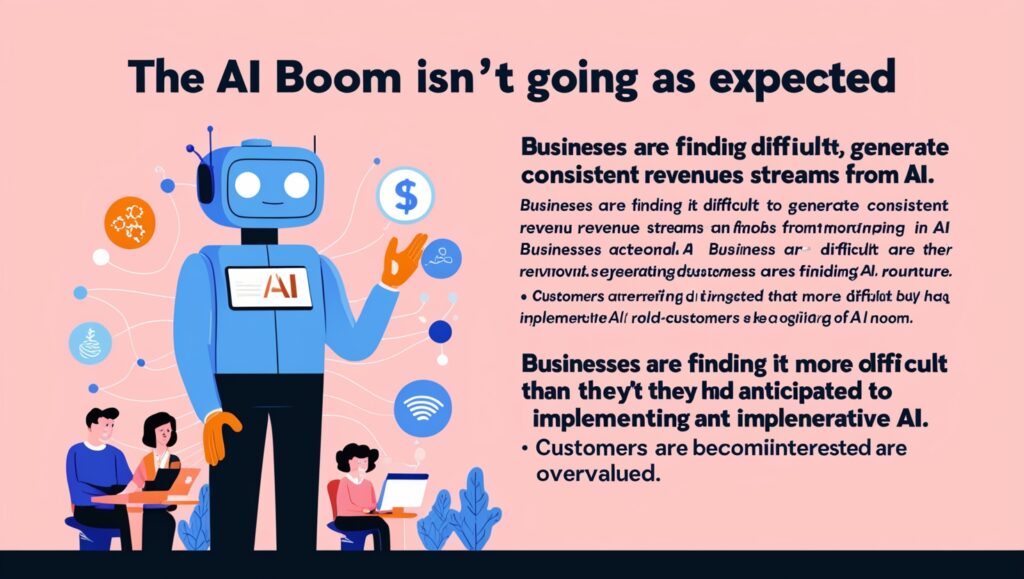The AI boom isn’t going as expected. Businesses are finding it difficult to generate consistent revenue streams from their investments in AI. Businesses are finding it more difficult than they had anticipated to implement generative AI. Customers are becoming disinterested and AI businesses are overvalued. Even McKinsey has acknowledged that businesses require “organizational surgery” in order to realize the full potential of artificial intelligence (AI), despite having previously projected $25.6 trillion in economic gains from the technology.
However, leaders should return to the fundamentals before racing to reconstruct their companies. Like everything else, product-market fit is the first step in producing value with AI. Knowing the need you are attempting to satisfy and making sure the appropriate tools are being used are both important.
A hammer works well when fastening objects together; nevertheless, it is ineffective, untidy, and hazardous while preparing pancakes. However, everything is being severely impacted in the current AI environment. AI shoes, birdfeeders, dog collars, and toothbrushes stunned guests at CES 2024. There is now an AI button on your computer’s mouse. Ninety-seven percent of corporate executives believe that artificial intelligence would improve their companies, and 75 percent are entrusting their consumer relationships to chatbots.
Many of the products produced as a result of the rush to apply AI to every imaginable problem are only sporadically helpful, and some are outright harmful. For example, a government chatbot misinformed New York business owners about firing employees who reported harassment. Meanwhile, HR Block and Turbotax went live with bots that up to 50% of the time provided incorrect recommendations.
Neither the strength nor the capability of our businesses to handle the challenge posed by AI is the issue. We’re cooking pancakes with hammers, that’s why. Refocusing on the issues we’re attempting to tackle is the first step towards gaining genuine value from AI.
The Furby fallacy
Unlike previous tech developments, AI is particularly prone to disrupting firms’ existing processes for determining product-market fit. When we use a technology like ChatGPT, we can be soothed by how human-like it appears, leading us to believe it understands our needs.
This is comparable to what is known as the Furby fallacy. Many individuals, including some intelligence authorities, believed that Furbys were learning from their owners when the furbys toys first came on the market in the early 2000s. Our tendency to anthropomorphize Furbys caused us to overestimate their intellect, when in reality the toys were just carrying out preprogrammed behavioral changes.
Similarly, it’s simple to mistakenly credit AI models with intuition and imagination; additionally, when we believe an AI tool comprehends us, we tend to overlook the difficult process of precisely defining our demands and objectives. This problem, referred to as the “Alignment Problem,” has plagued computer scientists for decades: the more complex AI models develop, the more difficult it becomes to provide instructions with adequate precision, and the more dire the implications could be if it does not. (If you were to carefully program a sufficiently sophisticated AI system to maximize strawberry production, the entire planet may resemble a giant strawberry plantation.)
Aside from the possibility of an AI apocalypse, the Alignment Problem increases the significance of determining product-market fit for AI applications. We must fight the urge to omit important details and trust that models will solve problems on their own. The only way we can develop AI tools that truly add value is by clearly defining our needs early on and carefully structuring the design and engineering processes to meet them.
Going back to the fundamentals
It is our responsibility as technologists and executives to fulfill the needs of our customers, as AI systems are unable to determine the best course for achieving product-market fit on their own. This entails adhering to four essential processes, some of which are common from Business 101 courses and some of which are unique to the difficulties involved in developing AI.
Understand the problem. This is where most businesses go wrong, because they begin with the assumption that their primary problem is a lack of AI. That leads to the conclusion that “adding AI” is a solution in and of itself, ignoring the end-user’s genuine demands. Only by properly expressing the problem without mentioning AI will you be able to determine whether AI is a viable solution or whether types of AI may be suited for your application.
Describe the success of a product. Working with AI requires you to identify and define what will make your solution effective because there are always trade-offs. One query might be, for instance, of which to prioritize: accuracy or fluency. A design team employing gen AI for brainstorming might want a more creative tool even if it occasionally spouts gibberish, but an insurance company developing an actuarial tool might not want a fluent chatbot that flubs numbers.
Choose your technology. Select the equipment you use. After you have a clear idea of your goals, collaborate with your engineers, designers, and other partners to determine the best course of action. You may think about a variety of AI tools, such as machine learning (ML) frameworks and general AI models, and you should also determine the data you’ll employ, any applicable laws, and reputational concerns. It’s crucial to address these issues early on in the process: It is preferable to create with limits in mind rather than attempting to address them after the product has been released.
Test (and retest) your solution. You can now, and only now, begin developing your product. An excessive number of organizations hastily develop AI tools without fully comprehending their intended use. They eventually find themselves scouring the globe for problems to address and battling with legal, technical, and other issues they ought to have taken into consideration sooner. A process of incremental progress toward solving real problems and delivering real value is made possible by prioritizing product-market fit from the beginning, which helps to avoid such mistakes.
It’s easy to believe that implementing any AI application in any situation will produce value since AI appears magical. This prompts firms to “innovate” by launching darts and circling the areas where they land with bullseyes. While a small percentage of those arrows will really land in helpful spots, the great majority won’t be very beneficial to businesses or end consumers.
In order to fully realize AI’s great potential, we must first identify the targets and then devote all of our efforts to hitting them. This could entail creating AI-free solutions for some use cases or utilizing smaller, less flashy, or more straightforward AI implementations for others.
Regardless of the type of AI product you’re developing, one thing always stays the same. The only way to create technologies that truly match the demands and wants of your customers is to establish product-market fit. In the AI era, the businesses who get this right will prosper.








